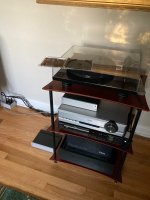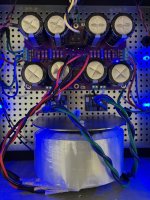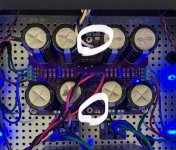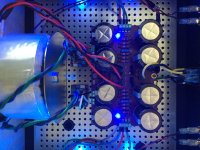I converted my Aleph 20 to balanced drive recently, as I have a balanced-out preamp that brings everything to the next level. Balanced drive seems to bring resolution and detail and it cleans up some of the harshness that comes with suboptimal sources. If you have the means, I highly recommend it.
Attachments
Whole heartedly agree. I only use balanced inputs, especially when it’s intrinsically designed, i.e. with differential input pair stage topologies seen with many Pass circuits or use a very well designed differential to SE circuit. I have done the same with input transformers, but you do have to spend a little bit on the transformer itself…although you do save a bit since they don’t need their own separate supply. Choices.
With Aleph inspired circuits, my advice is to go balanced input directly and enjoy the improvements!
Best,
Anand.
With Aleph inspired circuits, my advice is to go balanced input directly and enjoy the improvements!
Best,
Anand.
there is a slight difference in performance, speaking of gadgets having input LTP, between SE and bal feed......... but I believe that any significant perception difference in sound rather comes from change of feeding gadget you made
in short- I believe change is rather from change in preamp than in Aleph per se
or, if same preamp, it is simply superior in balanced output mode, which is completely normal for inherently fully balanced circuits, regarding output performance
not to forget - "superior" strongly depends of ears of beholder

in short- I believe change is rather from change in preamp than in Aleph per se
or, if same preamp, it is simply superior in balanced output mode, which is completely normal for inherently fully balanced circuits, regarding output performance
not to forget - "superior" strongly depends of ears of beholder

Whole heartedly agree. I only use balanced inputs, especially when it’s intrinsically designed, i.e. with differential input pair stage topologies seen with many Pass circuits or use a very well designed differential to SE circuit. I have done the same with input transformers, but you do have to spend a little bit on the transformer itself…although you do save a bit since they don’t need their own separate supply. Choices.
With Aleph inspired circuits, my advice is to go balanced input directly and enjoy the improvements!
Best,
Anand.
To be clear - if I am using balanced preamp outputs to balanced AJ inputs, an input capacitor is NOT required? I know you did not state that here, but it was alluded to in another post. My AJ (after warming up to about 40C) shows 1 or 2 mV of DC offset. I understand that's another way to avoid the coupling capacitor but it could be a long wait without AJ music!
If you can ensure that your source will always have a low DC offset, then yes, direct coupling and avoiding the input cap on the Aleph J is fine, as I did on the Aleph J Zen. However, I have found that if you are going for a certain ‘sound’ you can play with different input caps. Up to you, but remember the risk! This is a Classic Aleph thread though!
Best,
Anand.
Best,
Anand.
Yes, I have a stock AJ board. And I've tried rolling caps, but would really like to hear DC coupled. What did you find when you changed to DC? Significant difference?
As for the DC offset from the LS17, I'll have to measure that or find out from AR.
Thanks Anand for all your feedback.
As for the DC offset from the LS17, I'll have to measure that or find out from AR.
Thanks Anand for all your feedback.
I did my best to listen to the XP-10 in system extensively before I rewired the Aleph.there is a slight difference in performance, speaking of gadgets having input LTP, between SE and bal feed......... but I believe that any significant perception difference in sound rather comes from change of feeding gadget you made
in short- I believe change is rather from change in preamp than in Aleph per se
or, if same preamp, it is simply superior in balanced output mode, which is completely normal for inherently fully balanced circuits, regarding output performance
not to forget - "superior" strongly depends of ears of beholder

But still, I did try my best to compare SE in situ to balanced. And even though my standard interval for comparison is months, not days, I could not help but share, here, my revelations on the potential of the Aleph Classic with balanced drive. As biased as it may be.
not disputing what you said, just sharing my bias 
even if PL preamp is used, count on fact that its SE output is not on par with normal - Bal output
they're simply constructed as that, all virtues of SUSY core are present with native output ........ and SE is sort of auxiliary gizmo
that speaking in engineering way of things ..... on the other hand - my brain is crooked, I like proper drek, whichever way it is sounding

even if PL preamp is used, count on fact that its SE output is not on par with normal - Bal output
they're simply constructed as that, all virtues of SUSY core are present with native output ........ and SE is sort of auxiliary gizmo
that speaking in engineering way of things ..... on the other hand - my brain is crooked, I like proper drek, whichever way it is sounding
If you can ensure that your source will always have a low DC offset, then yes, direct coupling and avoiding the input cap on the Aleph J is fine, as I did on the Aleph J Zen. However, I have found that if you are going for a certain ‘sound’ you can play with different input caps. Up to you, but remember the risk! This is a Classic Aleph thread though!
Best,
Anand.
Yeah... C1 can easily be used to tune Aleph J sound to the rest of the system / individual preferences.
Without C1, the offset may never settle at exactly 0... it will vary somewhat... -10 to +10mV is the range you should aim for, without the C1 cap...
^ Nicely done!!!! ㊗️
(Why there is a Japanese congratulations button... I dunno... but it came up in the choices)
It makes zero, zilch, nada, no difference AT ALL from a functional standpoint with your wiring ... but... (there's always a but)... Black is line/hot and white is neutral per US mains wiring convention.
You also chose to use white and black (and red) with white used for - and + from different rectifiers. That would confuse me... but I'm easily confused.
Mainly wanted to say... awesome... but I am too much of a goof to have the same colors used for various things... particularly within the DC side (the two whites from the rectifiers).
Also... you've got your "audio gnd" connected to chassis gnd/mains earth (the baseplate - left side) and also the thermistor installed as the ground lift.... I'd reconsider that and/or ask someone way smarter, but I think that defeats the purpose at best and may cause issues at worst.
(Why there is a Japanese congratulations button... I dunno... but it came up in the choices)
It makes zero, zilch, nada, no difference AT ALL from a functional standpoint with your wiring ... but... (there's always a but)... Black is line/hot and white is neutral per US mains wiring convention.
You also chose to use white and black (and red) with white used for - and + from different rectifiers. That would confuse me... but I'm easily confused.
Mainly wanted to say... awesome... but I am too much of a goof to have the same colors used for various things... particularly within the DC side (the two whites from the rectifiers).
Also... you've got your "audio gnd" connected to chassis gnd/mains earth (the baseplate - left side) and also the thermistor installed as the ground lift.... I'd reconsider that and/or ask someone way smarter, but I think that defeats the purpose at best and may cause issues at worst.
The wire colors are kind of the way they are. I started out with a bunch and didn’t feel like ordering another bunch. I go back to them every couple months thinking I’m going to ”fix” things but never do.
I would like hear about the ground issue you see. If you can expand on that and offer a suggestion, I would appreciate it.
I would like hear about the ground issue you see. If you can expand on that and offer a suggestion, I would appreciate it.
Chassis ground issue.
Solder a wire or use a screw at the circled holes to connect the PCB chassis ground connection to the bottom plate. These connect chassis ground to the Audio ground through the CL60 that is located near one set of these connectors.
Solder a wire or use a screw at the circled holes to connect the PCB chassis ground connection to the bottom plate. These connect chassis ground to the Audio ground through the CL60 that is located near one set of these connectors.
Attachments
- Home
- Amplifiers
- Pass Labs
- Classic Aleph Amplifier for Modern UMS Chassis Builder's Thread






